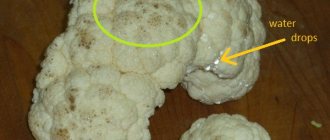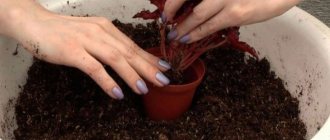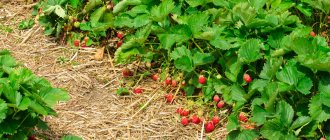Every gardener knows the bitter feeling of losing a harvest from insidious vegetable diseases. Unfortunately, it is impossible to prevent all threats to crops in your garden. However, many diseases can be recognized in time. This article will introduce you to the main diseases of cabbage, tell you about preventive measures and treatment, and also provide visual photos.
Clubroot cabbage
Description
This cabbage disease is expressed in infection of the root system of young and adult cabbage plants, most often white, red, cauliflower, savoy, Brussels sprouts and kohlrabi.
The causative agent of clubroot is a fungus. The source of infection can be soil and weeds of the cruciferous family. Dangerous for both open ground and greenhouses.
The disease is dangerous because it renders white cabbage seedlings unsuitable for planting and negatively affects the development of adult plants. Actively progresses on waterlogged soils with high acidity.
Signs of cabbage being damaged by clubroot: swelling of the roots, the formation of growths on them, yellowed and limp leaves, poorly developed heads of cabbage.
Photo of damage to cabbage by clubroot.
Methods of dealing with clubroot:
Agricultural technology:
General agrotechnical control measures for growing cabbage.
Agrochemistry:
Treating cabbage leaves with Fitosporin will reduce the chance of plants becoming infected with this disease (3 g per 1 liter of water).
Preventive spraying of the soil with Fundazol (10-15 g per 10 liters of water) before planting seedlings.
Treating seeds with Prestige will help not only protect plants from pests, but also prevent fungal diseases.
Thiovit jet (90-100 g per 2-3 liters of water per 10 square meters)
Agronomist's comment: There are no drugs that treat clubroot. There are products that reduce the acidity of the soil, thereby preventing clubroot disease in cabbage. Lime will help level out acidity (2-3 tones per 1 hectare, 20-30 kg per hundred square meters), but it is very important to know the soil pH for this. The disease is especially evident when cabbage is continuously grown in one place.
Recommended varieties and hybrids resistant to clubroot:
Ditmarscher, Kilastor F1, Bronco F1, Yamori F1.
7.Wet rot of cabbage
Description
Wet rot is caused by widely specialized bacteria that attack various vegetable and industrial crops. Most often, they settle on mechanically damaged, weakened heads of cabbage that are affected by other diseases during storage, especially at high humidity and temperature. These bacteria can cause wet rot in cabbage in the field. The outer leaves of the heads of cabbage and the stumps at the base of the leaves become slimy and rot. Gradually, rotting moves into the middle of the head of cabbage, it softens and begins to smell unpleasant. If diseased stumps are planted in the soil, their inner part turns into a soft mass and the testes do not grow.
Erwinia carotovora are rod-shaped bacteria with peritrichous flagella, 1.5-5X 0.7-0.8 µm in size, often found in chains.
The causative agents of wet rot are preserved in the unrotted remains of diseased plants in the field and heads of cabbage in storage. This disease is not transmitted by seeds.
Measures to combat this cabbage disease
Crop rotation. Timely spraying of seeds and cabbage plants of the first year against pests. Preventing the heads of cabbage from freezing during harvesting. After this, the removal of stumps from the field and deep plowing of the soil. Selection of only healthy heads of cabbage for the winter. Avoid storing different types of vegetables in the same room. Maintaining the temperature in the storage at about 0°. Planting only healthy queen cells. Checking the queen cells before storing them (if in a sample of 100-200 heads of cabbage 20% are affected by wet rot, the entire batch is rejected).
Root rot
Description
These diseases of cabbage seedlings affect cabbage, cauliflower, Chinese, Brussels sprouts, kohlrabi and broccoli, severely damaging the seedlings.
The fungus that causes root rot lives in the soil and actively develops under favorable conditions.
Signs of root rot: brown color of seedling stems, formation of dark constrictions on it.
Damage to cabbage with black leg.
Methods of dealing with black leg:
Agricultural technology:
Use healthy seed. Removing the remains of old and infected plants from the site. The correct sequence of planting vegetable crops in one place. Soil liming. Selecting the right irrigation system. Organizing a suitable light regime and temperature.
Agrochemistry:
An effective preventive measure against cabbage diseases are the fungicides “Trichodermin” (biological) and similar ones containing the fungus “Trichoderma” (say, “Mikohelp”) and “Previkur Energy” - chemical.
Agronomist's comment: It mainly occurs when seedlings are overcooled and flooded. An effective protective measure would be to shed the soil in advance, or better yet, with the first watering with Propamocard solution (Magnicur Energy or Energodar (4-5 g per 1 liter of water).
Varieties and hybrids of cabbage resistant to root rot:
Akira F1, Ankoma F1, Valentina F1.
Fusarium
Fusarium wilt of cabbage occurs due to fungi that are found in the soil. Most often, this disease appears in young seedlings of cauliflower or white cabbage growing at very low temperatures.
It is very easy to notice the disease, as it manifests itself almost immediately. At first, cabbage leaves are covered with yellow spots, which over time lead to complete wilting of the leaves. Due to infection, new heads of cabbage are not formed and the plant stops developing.
Cabbage fusarium is not treatable, so there are no effective methods to combat it. The only thing a person can do is to remove all infected bushes so that the infection does not spread further. You can also treat the area with copper sulfate for prevention.
Downy mildew or downy mildew of cabbage
Description
The second name is false or false powdery mildew. Affects white cabbage, cauliflower, Savoy, Peking cabbage, broccoli, kohlrabi.
A dangerous disease of cabbage seedlings also poses the greatest threat to the seed plants. It spreads quickly, like other diseases in open ground, as a result of which the plant dies, affected by rot.
Downy mildew can also form on cabbage already placed in storage, causing rotting of the stalk and making the cabbage heads unsuitable for further use.
Favorable conditions for the development of cabbage disease: high humidity, too thick seedlings.
Signs of peronospora/downy mildew: yellow or brownish spots on the top of the leaf, gray coating on the underside of the leaves.
Photos of signs of pernosporosis on white cabbage and cauliflower
Control methods:
Agricultural technology:
General agrotechnical control measures for growing cabbage.
Agrochemistry:
To prevent the disease, you can treat the seedlings with Bordeaux mixture.
If signs of damage to the leaves of seedlings by peronospora are detected, the fungicide Ridomil Gold can be used.
Agronomist's comment: Alternately changing fungicides during sowing will prevent fungal pathogens from developing immunity to the drugs.
Downy mildew-resistant varieties and hybrids:
Pushma F1, Reima F1.
Why do cabbage seedlings have purple leaves?
Reasons for the appearance of purple leaves on cabbage seedlings Experienced gardeners explain the appearance of purple leaves on cabbage seedlings by two conditions:
- lack of useful microelements, in particular nitrogen and phosphorus.
- stress suffered by the plant (picking, planting in open ground, lack or excess of moisture, low room temperature).
In the first case, the seedlings can be helped by banal feeding with the missing substances. It is worth noting that it is necessary to fertilize the plant in moderation. In the second situation, it is advisable to first find out what caused the stress, and only then take measures:
- If the seedlings are cold, then they need to be provided with comfortable temperature conditions.
- If there are problems with watering, they need to be solved.
- If the plant suffers from a change in environment, then you can simply give it time to acclimatize.
0
Fusarium wilt of cabbage (fusarium, jaundice)
Description
A fungal disease of cabbage that leads to the death of most crop plants on the site. Its main target is seedlings and adult plants of cabbage, savoy, cauliflower and broccoli.
The optimal conditions for the development of Fusarium wilt are hot and dry weather.
Signs of cabbage disease:
On seedlings. Yellowing of leaves. When cut, there are noticeable brown rings on the petiole.
On mature plants. The leaves fall off and turn yellow. Brown, dark rings on sections of leaves and stems.
Photo of cabbage affected by Fusarium wilt Control
methods
Agricultural technology:
General agrotechnical control measures for growing cabbage.
Agrochemistry:
Treatment with Fitosporin (paste) will be an effective prevention of cabbage seedling diseases. Before transplanting seedlings, you can place their roots in the solution for 2 hours.
Agronomist's comment: A very effective way for vegetable growing to combat Fusarium wilt is to use the drug Fundazol.
Resistant varieties and hybrids:
Kolobok, Valentina F1, Bronco F1, Megaton F1.
Radiation of fusarium
Problems and solutions
In our review you will find the most common cabbage diseases. We will tell you what the fight against them should be like.
The first thing that is required of the gardener is to pay attention to the condition of the leaves of the plants. They are the main marker reflecting a real lesion. The appearance of any spots may indicate fungal, viral and bacterial infections. Many of them cannot be treated, and the affected specimen must be quickly eliminated before the problem spreads. It is useful to consider the description and treatment of the most dangerous cruciferous diseases.
Blackleg
This is a fungal disease of cabbage that appears early in cultivation. Most often it affects seedlings when the first leaves are forming. Early ripening, early varieties are more susceptible to attack, but certain pathogens can provoke the death of late cabbage. There is no specific treatment. Affected seedlings must be disposed of immediately. You can try to save the rest of the seedlings by picking.
Reasons for development:
- use of contaminated seeds;
- overflow;
- violation of temperature and light conditions.
You can reduce the risk of blackleg in cabbage seedlings by adding bacterial fungicides and pesticides to the soil.
Downy mildew
Downy mildew is another cabbage disease of a fungal nature. It is common, rarely appears in open ground conditions, and is considered more dangerous for greenhouse plants due to high humidity.
Main features:
- yellow or brown spots of irregular shape appear on the upper side of the leaves;
- a gray coating appears on the bottom of the plates (spores appear);
- leaves turn yellow and die;
- Darkening vessels appear on the cut.
It is impossible to provide proper treatment; it will not be possible to save the seedlings, so it is important to follow preventive measures:
- choose resistant varieties and hybrids;
- use quality seeds;
- grow seedlings yourself;
- maintain the correct microclimate in greenhouses, eliminate waterlogging;
- Treat the seeds before planting.
Attention! If detected, the affected plant must be removed immediately. Treat visually healthy seedlings located next to it with fungicide three times (with an interval of 7 days).
Kila
The danger of this disease is that cabbage can become ill with it throughout the entire growing season. The first signs appear on the root system; compactions and growths form on it.
Natural development is disrupted due to the inability of the crop to obtain water. If the infection is severe, the leaves turn yellow and the heads of cabbage cannot be used for food. They simply will not form if the seedlings are sick.
There is no treatment, prevention must be provided. The simplest method of control is crop rotation. Nightshades (tomatoes, eggplants, peppers) have been grown on the plot for three years. You can plant garlic and onions.
The video will tell you more about the treatment of clubroot:
Fusarium wilt
A fungal disease that is common in the southern regions of Russia, but gardeners in the middle zone can also encounter it. Adult plants are affected.
Main features:
- yellowing of leaves;
- chlorosis in the lower part;
- gradual death of the plates.
To prevent damage, the drug “Agat-25” is used and the soil is treated with it. Preventive watering of plants with Fitosporin is useful.
Alternaria blight
Sources of dangerous fungal infections are plant debris and infected seeds. The fungus lives in the soil in the form of mycelium and conidia, spreads quickly, infecting seedlings and full-fledged plants with ovaries.
Classic preventive measures are used, but experienced gardeners advise treating plants against black spot during the growing season with preparations containing copper and sulfur. Preventive spraying with Quadris and analogues helps in the fight against Alternaria.
Fomoz
Another name for the disease is dry rot. It can affect all varieties of cruciferous vegetables, but cabbage varieties are more often affected. Light spots appear on young plants, which then darken. There is growth retardation. Tissues are destroyed rapidly. Culture is dying. It is impossible to save it, so it is necessary to regularly treat the beds with fungicidal agents.
Gray rot
This cabbage disease rarely appears in garden beds, but gardeners encounter it regularly. Its symptoms occur during storage. The outer leaves become covered with brown spots. During the growing season, the problem arises due to increased air humidity and mechanical damage to the head of cabbage. In this case, it must be cut and used, removing the damaged plates.
Attention! A crop affected by gray rot loses its shelf life and must be processed. The product is safe to use for humans.
White rot
Caused by marsupial fungus. Defeat is dangerous for all cruciferous crops. It occurs on seedlings, at the end of the growing season and during the storage period of cut heads of cabbage. Sclerotinia, watery soft rot are the names of the same disease.
Characteristic symptoms:
- sliminess and rotting of outer leaves;
- the appearance of a dense white coating;
- rapid decay.
More often, the problem occurs when improperly collected and stored, when the heads of cabbage are cracked, overripe, frostbitten or damaged. The danger of the problem is its rapid spread, so before sending it for storage, you must carefully inspect the crop, removing damaged elements.
Vascular bacteriosis
A bacterial disease called black rot. It affects all cruciferous plants at different stages of development: from the appearance of the first shoots to ripening. Affected vegetables are unfit for consumption and their appearance and taste change. If damaged, the heads of cabbage will be underdeveloped. The problem spreads quickly, leading to the loss of 90% of the crop.
Point necrosis
Another name for the disease is cabbage mosaic. It is non-infectious in nature and manifests itself in a plant when there is a metabolic disorder in its tissues.
The problem is often related to the weather and non-compliance with agricultural standards:
- temperature fluctuations;
- using nitrogen in excess;
- bay.
Attention! Interestingly, the mosaic appears not only during the growth period, but also during storage. The reason is incorrect conditions.
Apical burn
This is a natural indication that the culture lacks calcium. The leaves turn yellow, brown, and then die. The plates located at the center of the rosette are susceptible to the disease, so the problem in the case of a formed head of cabbage appears after cutting it. They encounter it when growing white cabbage, Chinese and Brussels sprouts.
Cabbage blight
Description
It's dry rot. The spectrum of damage to this disease is quite wide: seeds, seedlings and adult plants of all types of cabbage. But this disease most severely affects cabbage. Even on heads of cabbage placed in storage, it continues to develop, leading to their rotting.
It develops more intensively in high humidity and warm climates. Whole heads of cabbage disease affected by cabbage disease completely rot, while partially infected heads slow down in development and lose their marketable appearance.
Signs of the disease: darkening at the bottom of the stem on seedlings. In mature plants you can notice it by brown spots with a dark dot in the middle. Dry rot on the roots and yellowing are also characteristic. It may be similar in appearance to root rot (blackleg), but differs in color.
Photo of photobosis on cabbage
Control methods
Agricultural technology
General agrotechnical control measures for growing cabbage.
To avoid the formation of dry rot in heads of cabbage during storage, you need to sort the harvested crop and organize the optimal temperature regime. Heads of cabbage with mechanical damage to cabbage are very vulnerable to this disease, so you should avoid them.
Agrochemistry
Improving the resistance of heads of cabbage to cabbage disease is facilitated by treatment with a mixture of trichodermin and phytocide R (10 ml of each preparation), preferably in conjunction with an adhesive or liquid soap. The seedlings are treated immediately after transplanting into open ground, and then every three to three and a half weeks.
Resistant varieties and hybrids:
Langedijker, Turkis, Kraft F1.
Dangerous pests
There are many insects that harm the plant. They are attracted to the tasty and nutritious leaves of cabbage. They are dangerous not only because they eat plants, but also because they are considered the main carriers of diseases, viruses and fungi.
Cabbage aphid
Small green pests completely cover cabbage leaves. Insects feed on the juice of heads of cabbage, and well-transparent areas appear on the affected areas. Leaves change over time, dry out and die.
Aphids are the most common harmful insect; they pose a danger to all types of cabbage.
Control methods: pests do not like strong odors; they do not attack crops growing next to marigolds, basil, lavender and other aromatic plants. The best results come from carrots, dill, parsley and garlic. These herbs can be used to create infusions. You can use tobacco, hot peppers, and tomatoes as spraying agents.
The only enemies of pests are birds, especially sparrows and tits; earwigs also pose a danger to them. Birds are attracted by feeders and drinkers.
If there are not very many aphids on the cabbage heads, then you can use soap suds or a solution of soda ash. If the desired result is not achieved, then chemical agents are used, for example, Fitoverm, Iskra-Bio, Corado or Commander. Often it is enough to carry out a couple of treatments to completely destroy aphids.
Cruciferous bug
Pests suck the juice out of the cabbage, it dries out and stops growing. Early varieties of cabbage are practically not affected by the cruciferous bug - when the pest becomes active, the plant has already grown a sufficient amount of green mass, and the bug can no longer cause harm.
Control methods: the soil is treated with Fosbecid, Actellik or Belofos. If the bugs have captured all the plants, then the soil is treated with twice the concentration of drugs. As a preventive measure, cabbage is treated with infusions of chamomile, potato tops or tomato decoction.
Cruciferous flea beetle
A special pest that can turn a plant into a sieve in a couple of days. They eat the seedlings in 2 hours. Insects cause more damage in the spring, when the temperature reaches +15 degrees.
Control methods: when insects are detected, use Decis, Karate, Aktara or Bankop.
Experienced gardeners claim that a solution of water (10 l) and flea shampoo for animals (100 ml) brings excellent results.
Slugs
These nasty creatures climb onto the leaves and eat them. A slippery coating remains on the greens. The heads of cabbage do not last long, and their presentable appearance deteriorates significantly.
Methods of control: slugs are collected with one’s own hands; due to the slow movement, this is done very simply, although unpleasantly. You can use numerous folk remedies, for example, bury a container with beer, sugar syrup or jam in the ground, the slugs climb into them and cannot get out again.
The main enemies of these pests are hedgehogs, starlings and toads, so try to attract your saviors to the garden.
It is better to use chemicals only during a long-term and massive attack of pests; the best of them are Thunderstorm, Meta and Slug Eater.
Cabbage moth
Caterpillars begin to become active during prolonged heat. Affected cabbage stops growing, dries out and no longer develops. Adult moths are not harmful to plants, but you should be wary of caterpillars.
Control methods: use a decoction of tomato tops, mustard and ground pepper. Plant a couple of tobacco bushes throughout the garden area; its smell will repel the pest. Also make protection from mustard, cilantro and clover. Spray the heads of cabbage with any chemicals against caterpillars.
Cabbage whites
Many gardeners know this pest as the cabbage butterfly. She lays about 200 eggs, the individuals hatch, and within a couple of days they completely eat the crop.
Control methods: inspect the plant from all sides, destroy the eggs immediately. You need to fight whites in the same way as cabbage moths. Use Kinmiks or Fitoverm as pesticides.
Cabbage scoop
They are caterpillars that make tunnels in cabbage.
Control methods : collect eggs and individuals by hand, spray the heads of cabbage with a solution of pepper pods and water. You can try special products that give good results: Inta-vir, Sherpa and Karate.
The pest does not attack en masse, so they get rid of them quickly.
Rapeseed sawfly
Pest larvae destroy cabbage stems and leaves from the inside. In addition to the heads of this crop, pests are dangerous to carrots, parsley and coriander, so they should be planted further away so that the insect does not move from one crop to another.
Control methods: spray the heads of cabbage with infusion of wormwood, chamomile or aconite. Another option is to use a mixture of soda ash (10 liters of water + 70 g of product). The following remedies are effective: Arrivo, Aktaroy, Metaphos, Phosfamide.
Cabbage fly
Adult pests lay eggs in the soil, the larvae are absorbed into the root system and destroy the plant invisibly. The heads of cabbage slow down in development and dry out completely.
In May, the cabbage fly manifests itself most noticeably.
Control methods: when planting seedlings in the ground, add Pochin, Zemlina or Bazudina to it. While loosening the soil, add a mixture of mustard or wood ash. If you find insects, destroy them with Rovicurt or Trichlorometaphos.
Whitefly
Noticing the insect is very simple, they are white in color and look like a moth. Larvae and adults feed on cabbage juice and develop at high temperatures and humidity.
When making traps, rely on the fact that adult pests like yellow, and larvae like blue.
Control methods: repel insects with a solution of yarrow, garlic or laundry soap. If folk remedies are powerless, then use drugs such as Inta-Vir, Talstar and Fitoverm.
Watch a video about cabbage pests - how to fight them (mainly with folk remedies), and they will also tell you about the terrible Kila disease and how to avoid it:
General pest prevention
Every summer resident knows that it is better to take care of a problem in time than to think about how to get rid of it later.
Preventive actions:
- Dig up the garden bed in the fall. This helps to destroy all fungal larvae and spores.
- In spring, do not apply manure; many pests overwinter in it.
- Weed and loosen the soil throughout the summer season.
- Remember crop rotation. The best option is to replant the cabbage every year in a new place. Good predecessors: beets, aromatic herbs.
- Maintain distance between seedlings. When planted close together, insects spread faster.
- Do not hesitate to plant cabbage in open soil - the crop has weak immunity.
- Take a good look at the planting material.
- Do not hesitate to throw away or burn a diseased plant.
- After detecting a disease or pest, treat the soil.
Cabbage has weak immunity, so it is often attacked by diseases and pests. However, competent preventive measures will help reduce the risk of infection, and the gardener can count on a rich harvest.
0
0
Copy link
Alternaria blight
Description
He's a black spot. A fungal disease that can spread through seeds, soil, or wind. It affects both seedlings and adult plants. It spoils the appearance of heads of cabbage and makes them unsuitable for sale and consumption.
Signs of Alternaria blight: cracking at the end of the pod, dark spots on the leaves with a yellow outline.
Photo of Alternaria damage to cauliflower and white cabbage
Control methods
Agricultural technology
General agrotechnical control measures for growing cabbage.
Agrochemistry
For prevention, folk remedies such as Bordeaux mixture and copper oxychloride are used.
Fundazol also increases plant resistance when sprayed during the growing season.
Fungicide Quadris is used to prevent Alternaria in cabbage or after its early signs appear.
Agronomist's comment: for prevention the drugs Champion, Quadris, for treatment Switch, Skor.
Resistant varieties and hybrids:
Supermarket F1, Galaxy F1, Arles F1, Nozomi F1.
Alternaria (cabbage black spot)
The causative agent of black spot belongs to the genus of fungi. The habitat is ubiquitous, regions with high humidity are especially affected. Alternaria does not spare either seedlings or adult heads of cabbage. Cabbage becomes infected in several ways:
- Seminal. From the name it is clear that in this case the cabbage seeds are contaminated with spores. On their surface, the pathogen can remain viable for up to 24 months, and if the fungal mycelium penetrates inside, then for 12 years.
- Soil - if there are remains of cruciferous plants infected with Alternaria in the ground. Weeds are also carriers of the pathogenic fungus.
- Wind. Spores are carried by the wind over long distances.
Carriers can be gardening tools, insects, animals and even people. Spore dispersal occurs in dry weather, but mycelium germinates when there is moisture on the surface of the leaves.
You can tell that cabbage is infected by local dark brown or black spots on the leaves (see photo), often with a yellow border. The spots look like they are covered in soot, which comes off easily when touched. This plaque is the spores of the fungus.
In order to significantly reduce the chances of cabbage becoming infected with Alternaria, you should follow the following rules:
- process seeds;
- avoid varieties prone to this disease;
- remove plant residues from the soil;
- mulch the soil;
- observe correct crop rotation;
- avoid over-irrigation;
- apply fungicides;
- Harvest carefully and store properly.
Late blight of cabbage
Description
The fungus that causes cabbage to slowly die off enters the plant from the soil. More dangerous for tomatoes or cucumbers, but sometimes affects some types of cabbage. Favorable conditions for the development of late blight are rainy weather before and during harvesting.
Signs of the disease: browning of leaves, plant tissues turn gray and die.
Photo of late blight on cabbage
Control methods
Agricultural technology
General agrotechnical control measures for growing cabbage.
Agrochemistry
Preventive treatment with Quadris.
Agronomist's comment: To counteract, you can use Ridomil or Acrobat. You should definitely pay attention to the concentration (100 ml per 10 liters of water) . An excellent choice would be the fungicide Charivnyk, which is a mixture of Ridomil and Acrobat.
Gray mold (Botrytis)
Description
A fungus that attacks cabbage and other cruciferous vegetables. Cabbage disease spreads from the lower part of the plants, initiating rotting of the roots and heads themselves, from which the plants most often die.
Favorable conditions for the formation of gray rot are rainy weather, frost and mechanical damage to plants.
Gray rot is especially dangerous for heads of cabbage placed in a cellar/pantry/warehouse, reducing shelf life to 2-3 years, or even destroying them altogether.
Signs of gray rot:
On the harvested crop: gray coating, mucus on the leaves. In the field, gray rot rarely develops and is usually recognized by brown spots on the leaves.
Photos of signs of damage to white cabbage and cauliflower by gray mold
Control methods
Agricultural technology
General agrotechnical control measures for growing cabbage.
Proper watering system (warm and infused water). Optimal fertilizing regime (complex fertilizer). Harvesting fruits at the optimal time (dry weather).
Agrochemistry
Preventive treatment with Fitosporin M. Dilute 10 ml of fungicide into a 10-liter container. This is enough for about a hundred.
Treat the seedlings for the first time 10 days after planting, and the second time after 14-21 days.
Spraying plants with a solution of Bordeaux mixture.
Agronomist's comment: When cabbage is damaged by gray and white rot, Switch, Skor, Blue Bordeaux will help. They are used as a preventive measure against these diseases; already affected heads of cabbage should be thrown away to avoid the spread of the fungus to the remaining crop.
Resistant varieties and hybrids:
Amtrak F1, Galaxy F1, Akira F1.
Cabbage pests: photos, descriptions and treatment
Parasites can cause significant damage to the crop. Wanting to feast on young plants, they begin to attack seedlings in the spring, while they not only damage the plants, but also transmit viral and fungal infections. In order for cabbage to produce a good harvest, pests and diseases, fighting them and regular preventive treatments are simply necessary.
Detailed information about cabbage pests and ways to combat them with folk and chemical means can be found in our article.
Cabbage pests photo description and control methods
Cabbage aphid (lat. Brevicoryne brassicae)
If you do not regularly treat the crop, pests of white cabbage will definitely appear, and fighting them will be much more difficult than preventing them from appearing. One of these parasites is aphids, which feed on plant sap. Small insects are small in size and silvery-white in color. Located on the lower part of the leaf, they gradually deplete the plant.
Cabbage aphids feed on plant sap and weaken them
Even in the spring, when planting the first seedlings, aphids settle in colonies on young cabbage. The presence of a pest can be determined by external signs:
- plant development slows down;
- the leaves lose their natural color and a pink tint appears;
- Gradually the leaves curl and die.
Signs of aphid infestation of white cabbage
To combat aphids, insecticides are used, such as: Karbofos, Iskra, Karate. In a small private household, you can scare off unwanted insects with the pungent smell of tobacco, infusion of garlic or onion peels. Aphids do not tolerate proximity to carrots and tomatoes.
Cabbage fly (lat. Delia radicum)
White cabbage and cauliflower, whose pests and diseases are usually different, can be affected by the cabbage fly. The insect is practically no different in appearance from the common house fly.
Cabbage fly is a dangerous pest for cauliflower and white cabbage.
Starting from the end of May, the cabbage fly lays eggs in the soil, and a week later the young larvae begin to feast on the root system of the plants. You can determine the presence of a fly on cabbage by the appearance of the bushes:
- the roots rot and the plant is easily pulled out of the soil;
- the bushes wither;
- the lower leaves take on a leaden gray color.
We identify the cabbage fly by the appearance of the cabbage bushes.
When a pest is detected, the plantings are treated with a 30% solution of Thiophos. The drug is diluted with water to a concentration of 0.03%, consumption per plant is 0.25 liters. A 65% solution of Chlorophos, diluted to a concentration of 0.25%, effectively fights flies. Consumption - 0.2 l per bush.
You can scare away the pest with the strong smell of tobacco mixed in equal proportions with lime. 1 part naphthalene with 7 parts sand will also help cope with the problem.
Cruciferous flea beetles (lat. Phyllotreta cruciferae)
Small oblong black bugs live in the soil, and with the arrival of spring they begin to feed on young plants: first weeds, then seedlings. Affecting all types of cruciferous plants, flea beetles feed on the upper layers of the leaf, leaving behind sores.
Young plants often cannot tolerate the pest and die, while older and stronger plants do not produce a good enough harvest. The peculiarity of the cruciferous flea beetle is that it does not tolerate wet weather.
Dangerous pests of cabbage - cruciferous flea beetles
Among the folk methods of control, spraying of plantings with a soap solution, or dusting with a mixture of wood ash and road dust is often used. Among the chemical preparations, insecticides such as Karbofos, Aktara have proven themselves.
Damage to cabbage leaves by cruciferous flea beetles
White rot (sclerotinia)
Description
Cabbage disease, affecting mainly adult plants in open ground. Dangerous for all types of cabbage.
In greenhouses and other types of shelters, it sometimes affects seedlings. It actively begins to manifest itself before harvesting, subsequently provoking rotting of the heads of cabbage in storage. Conditions for intensive development: frost and high humidity.
Signs of the disease: mucus on the outer leaves, white mycelium, similar to cotton wool, forms on the head and leaf apparatus, dark-colored structures (sclerotia) appear on the upper side of the head.
Photo of damage to white cabbage and broccoli by white rot
Methods of control
Agricultural technology
General agrotechnical control measures for growing cabbage.
Already affected heads of cabbage will have to be thrown away..
Agronomist's comment: When cabbage is damaged by gray and white rot, Switch, Skor, Blue Bordeaux will help. They are used as a preventive measure against these diseases; already affected heads of cabbage should be thrown away to avoid the spread of the fungus to the remaining crop.
Resistant varieties and hybrids:
Craft F1, Akira F1.
How diseases appear
The main reason for plant infection with infectious diseases is the gardener’s ignorance of the basic rules of agricultural technology.
The list of main violations that aggravate the prognosis for the recovery of cabbage and contribute to the spread of the problem:
- ignoring the basic rules of crop rotation;
- neglect of procedures for disinfecting soil and planting material before sowing;
- plant remains that were not removed from the garden after harvesting;
- waterlogging during watering;
- refusal to use fertilizers (they not only accelerate the growth of crops, but also make them more resilient);
- abuse of nitrogen fertilizers at the beginning of the growing season;
- attacks by pests carrying fungal spores and viral particles.
You should be especially careful when choosing high-quality seedlings, because it is with planting material that the disease can be introduced to the site. You should not buy young cabbage at spontaneous markets. It is better to sow it yourself or contact trusted nurseries.
Attention! It is almost impossible to verify the quality of the purchased seedlings. Fungal spores and viruses are invisible to the naked eye. Symptoms may appear after 1-2 days.
Cabbage diseases affect not only the usual white cabbage variety, but also others: Beijing, Brussels sprouts, Savoy, kohlrabi. Microorganisms are not selective, so it is worth monitoring the condition of all plantings.
Often unfavorable conditions contribute to the spread of the problem:
- temperature fluctuations;
- constant rains;
- strong wind.
The main task of the gardener is to detect the problem in time and concentrate his efforts on eliminating it. To make it easier to identify the defect, it is worth considering a description of cabbage diseases with photos. This way it will be possible to make a comparison with the existing characteristics and decide on the appropriate treatment method.
Powdery mildew
Description
A cabbage disease that acts very quickly and is transmitted very easily. Its main targets are seeds and seedlings, and sometimes infects heads of cabbage in storage. It poses a danger to seedlings in greenhouses and greenhouses, and sometimes infects plants in open ground.
Like many other diseases of white cabbage, powdery mildew progresses with high humidity levels and too thick crops. It is also dangerous for Brussels sprouts, kohlrabi and broccoli.
Leads to the fall of seedlings, deterioration of seed development, rotting and death of plants in storage.
Signs of the disease: yellow spots on the top of the leaf, gray plaque on the underside.
Signs of powdery mildew on cabbage
Control methods
Agricultural technology
General agrotechnical control measures for growing cabbage.
Organization of proper watering. Irrigation is carried out at the root so as not to over-wet the leaves, thereby creating favorable conditions for the development of the disease.
Agrochemistry
To prevent and treat powdery mildew, you can use Fitosporin, which is applied by spraying.
Resistant varieties and hybrids:
Slava, Amager, Dzhetodor F1.
Blackleg
A fungal disease called blackleg is a scourge for seedlings of vegetable and flower crops. The source of infection is the soil. Contributing factors for the development of the disease are:
- poor ventilation;
- planting density;
- bad light;
- changes in humidity and temperature.
The disease manifests itself as darkening at the root part of the stem. This is a colony of the fungus, clogging the vessels of the plant and causing the seedlings to wither. If one specimen is affected, then there is a very high probability that neighboring shoots are also infected.
To prevent blackleg damage, it is necessary to treat the soil intended for growing cabbage seedlings. Various methods are used:
- in the oven on a baking sheet, the soil is calcined at a temperature above 100ºC for 30 minutes;
- use hot steam or a microwave oven;
- frozen in the freezer;
- spill the soil with potassium permanganate or boiling water.
Cabbage seeds also need to be processed or purchased already prepared, which will be indicated on the package.
If the disease does appear on the plant, then it should definitely be removed by the roots. Then the container in which the seedlings are located should be filled with wood ash or crushed charcoal. It would be a good idea to spill the soil with a weak solution of potassium permanganate. After such watering, allow the soil to dry for a week.
Specialized drugs (for example, Fitosporin) are used for both prevention and treatment of blackleg.
White rust
Description
It poses a great danger to open ground. Conditions for intensive development of the disease: high humidity, lingering fogs, heavy dew. Because of this fungus, plants lose their marketable appearance and develop poorly. Affects all main types of cabbage.
Signs of cabbage disease: white cavities with pus on the leaves and stem, deformation of the leaves, disruption of their structure, curled tips.
Photos of signs of damage to white cabbage and broccoli by white rust
Control methods
Agricultural technology
General agrotechnical control measures for growing cabbage.
Agronomist's comment: Topaz fungicide (0.125–0.15 per hundred square meters) will help well.
Agrochemistry
If symptoms of the disease appear, you can spray with Ridomil.
13.Fomosis (dry rot) of cabbage
Description
A fungal disease that affects all organs of cabbage plants at different stages of development. Sometimes the disease manifests itself on seedlings after planting them in the ground. In this case, the pathogen spreads in the roots and root collar, causing tissue death. Pale spots appear on the leaves and petioles. Phomasis most often affects the testes. A characteristic sign of this disease is grayish-brown rounded, sometimes concentric, dry spots with numerous black dots - pycnidia (a). Only on the pods are spots of irregular shape and dark gray color. Testes affected by Phoma, as a rule, die in the phase of pod formation. In the outer parts of the stumps of the affected heads of cabbage, large, deeply depressed grayish spots with numerous pycnidia are visible (b). In them, pycnospores (c) develop on colorless, cylindrical, 8-µm-long conidia. They are single-celled, ellipsoidal, colorless, with blunt ends, sometimes curved, 3.5-6X0.8-2 µm in size, with two oil droplets.
The causative agent of the disease persists with plant residues in the soil, with seeds and on infected heads of cabbage. Overwintering pycnospores do not lose their viability for one to three years.
Control measures
Crop rotation. Plowing in plant residues. Thermal and chemical disinfection of seeds. A set of agrotechnical measures that promote the normal development of plants. Destruction of diseased and poorly developed testes. During the growing season, spray the seeds with fungicides.
Mosaic of turnip cabbage
Description
The disease often occurs in open ground. Both seedlings and mature plants are susceptible to it. It infects all types of cabbage (most often white-headed cabbage, broccoli and cauliflower). It negatively affects the marketable appearance of the crop, causes growth retardation, and renders healthy heads of cabbage unusable for further use.
Actively progresses in warm and dry climates, a large number of weeds and pests.
Signs of the disease:
Light green spots on the bottom of cabbage leaves, then in these places the tissue begins to die, black spots are observed on the surface of the leaves. Deformation of the leaves, mosaic, slow development and swelling are also observed.
Photo of the manifestation of the turnip mosaic on white and Chinese cabbage
Control methods
Agricultural technology
General agrotechnical control measures for growing cabbage.
Constant prevention and control of aphids, the main carrier of the disease.
Agrochemistry
Agronomist's comment: It is impossible to cure turnip mosaic. Therefore, prevention is very important. For example, treatment with Farmayod.
Mosaic
To date, at least 6 mosaic viruses are known to infect cruciferous crops. But two are recognized as the most significant:
- cauliflower mosaic virus (CaMV);
- Turnip mosaic virus (TuMV).
Both varieties are transmitted by mechanical contact and by cabbage aphids.
Most often, cabbage disease symptoms appear on the lower leaves in the form of a patterned pattern along the veins of the leaf blades. The patterns consist of dark and light green areas, which subsequently become necrotic. The leaves themselves become wrinkled and deformed, and the veins become discolored.
When the temperature rises to 22°C, the development of the disease slows down, but the virus can be transmitted to neighboring plants. It is not possible to cure cabbage infected with the mosaic virus. Therefore, preventive measures come to the fore:
- Weed control (especially the cruciferous family).
- Using insecticides to kill aphids.
- Growing genetically resistant varieties.
- Disinfection of garden tools.
Vascular bacteriosis of cabbage
Description
A bacterial disease that mainly affects cabbage seedlings after transplantation to the site. It provokes a strong slowdown in growth and prevents the formation of a head of cabbage. Progresses quickly in hot weather and humid environments. Common among major cabbage varieties
Signs of the disease: yellowing of cabbage leaves along the edges, then it progresses to the middle, the veins darken, darkening is found on the cut of the stem and stalk.
Photo of vascular bacteriosis on white and Chinese cabbage
Control methods
Agricultural technology
General agrotechnical control measures for growing cabbage.
Agronomist's comment: Kazumin is an excellent antibiotic for plants. There is also a more affordable method - treatment with metronidazole, available at any pharmacy (in liquid form, 0.5-1 l per 1 ha)
Resistant varieties and hybrids:
Bruno F1, Zoltan F1, Transam F1, Saxesor F1.
Mucous bacteriosis of cabbage
Description
A bacterial disease that mainly affects adult plants; the seed plants are rarely affected. It may further progress in heads of cabbage in storage. Leads to the fact that the middle of the head of cabbage becomes soft and emits a pungent odor. Dangerous for almost all types of cabbage.
Begins active development during heavy precipitation and high moisture levels.
Symptoms: rot, mucus, and unpleasant odor form in infected areas.
Photo of mucous bacteriosis on cabbage
Control methods
Agricultural technology
General agrotechnical control measures for growing cabbage.
Control of disease-carrying pests (cabbage fly, bedbugs).
Agronomist's comment: I recommend treatment with metronidazole, you can buy it at any pharmacy (liquid, 0.5-1 l per 1 ha).
Resistant varieties and hybrids:
Cossack F1, Dijon F1, Typhoon F1.
As a conclusion, we can say that to counteract cabbage diseases, it is enough to adhere to the basic rules of agricultural technology: crop rotation, weeding, removing old plant debris from the site, using healthy seed, optimal thickening and watering.
Treatment of a specific disease is possible, but it is much easier and more effective to use both agrotechnical measures and fungicides in the form of prevention, preventing infection.
Diseases of viral and bacterial nature
In addition to fungal diseases, cabbage can be affected by diseases of another nature: viral or bacterial.
Vascular bacteriosis
Pathogen: bacterium Xanthomonas campestris. The bacterium can infect plantings at any stage of development. From seedlings to cellar storage. During this period, a friend and relative of Xanthomonas, mucous bacteriosis, often appears. This threatens the loss of up to 50% of the harvest.
The disease affects the entire cabbage family, and weeds too (shepherd's purse, common rape), which subsequently become a breeding ground for infection. Favorable conditions - warm days, cool nights.
Infection occurs:
- from seeds,
- through the soil
- if there was mechanical damage to the plants (open gates for infection),
- harmful insects,
- promotes the spread of rain and wind,
- abundant watering of the beds from above,
- plant remains,
- not rotted manure.
How does the disease manifest?
- The leaf veins darken and a characteristic black mesh appears.
- Plant growth slows down and they become crooked.
- The bacterium infects the vessels of the plant, causing them to turn black.
- Later the leaves dry out and fall off the bush.
Vascular bacteriosis on cabbage
How to combat vascular bacteriosis?
- First of all, observe crop rotation (the bacterium lives in the soil for up to 3 years), the best predecessors are peas, beans, cucumbers, beets
- fight weeds and harmful insects
- treat seeds and seedlings with biological preparations, for example: Fitolavin-300
There are many varieties of F1 resistant to the disease:
- Typhoon,
- Aggressor,
- Braxan,
- Dominant.
Vascular bacteriosis on cabbage
Mucous bacteriosis
The causative agents of mucous bacteriosis are the bacteria Pectobacterium carotovorum subsp. carotovorum (Jones) Waldee. The disease affects many types of garden and weed plants. Distributed throughout the Russian Federation.
The first signs appear during the ripening period of heads of cabbage. Seedlings suffer less often. White cabbage and cauliflower are primarily susceptible.
Oily spots and a characteristic putrid odor appear on the affected surface. Cauliflower also has problems - spots of rot appear on the inflorescences. Gradually the entire head turns into a rotting mass. Rot can creep up from the soil along the stalk, which becomes soft. The cabbage is rotting on the vine. Often it joins and contributes to the development of rot, a neighbor and brother - vascular bacteriosis. In storage, such vegetables completely rot.
Mucous bacteriosis on cabbage heads
Sources of infection:
- harmful insects (cabbage aphids, cabbage moths, slugs, various mites),
- plant remains,
- irrigation water,
- the soil/
Favor the development of the disease:
- air humidity more than 50%,
- high air temperature,
- heavy rainfall.
Ways to protect plants and crops:
- well-thought-out agricultural technology (crop rotation, fertilizing with potash fertilizers, careful care of crops)
- pest and weed control
- growing disease-resistant F1 hybrids
- improvement of seeds with TMTD preparation
- as a preventive measure, watering the holes with the biological product “Binoram” before planting
- cleaning and disinfection of vegetable stores
- storage mode at 0…+5 C.
Mosaic
The disease begins with the Cauliflower mosaic caulivirus virus, which is brought by various sap-sucking insects (aphids, herbivorous mites). Infected seeds, cruciferous weeds, and mechanical damage to the surface of plants also contribute to infection by the virus.
All types of cabbage suffer from mosaic : white cabbage, kohlrabi, savoy, cauliflower, leaf cabbage. And also cruciferous relatives: turnips, rutabaga, horseradish.
First signs:
- on young leaves veins are indicated in the form of a mosaic.
- Dark green borders appear next.
- Necrotic spots appear on the leaf tissue between the edges.
Mosaic on cauliflower
Usually signs of the disease appear 20-30 days after planting the seedlings. If the heat sets in, the life of the virus temporarily stops.
Ways to combat the virus are rather preventative:
- seed preparation, for example heat treatment (hot water, then bathing in cold water)
- treatment of seeds with biological, growth-stimulating preparations (“Fitocid”, Agat-25″)
- diseased plants are burned
- weed control
- uncompromising war against harmful insects!
Diseases of cabbage by growth phases (seeds, seedlings, planted plants, heads in storage)
Some cruciferous diseases appear only at a certain stage of growth, while others can affect it at any stage of growth. This block will demonstrate a list of popular diseases by growth phase of cabbage, both mature plants and cabbage seedlings, photo descriptions and treatment are indicated in the list above.
Diseases of cabbage seedlings
- Blackleg
- Fusarium
- Downy mildew
- Fusarium wilt
- Dry rot (Fomoz)
Cabbage seeds
- Alternaria blight
- Dry rot (Fomoz)
- Downy mildew
Mature plants
- Kila
- Rhizoctoniosis
- White rot
- Late blight
- Mosaic of turnip cabbage
- Dry rot of cabbage (Fomoz)
- Mucous bacteriosis of cabbage
- Fusarium wilt
Cabbage heads in storage
- Powdery mildew
- Dry rot (Fomoz)
- Gray rot
- White rot
- Powdery mildew
The reason is bacteria
Mucous bacteriosis of cabbage can affect the plant at any stage of development. Rotting may begin in the outer leaves. They resemble a mucous structure and smell unpleasant. Gradually the entire head of cabbage is subjected to rotting.
There is an option for rotting to start from the inside of the head of cabbage. Bacteria can be carried by pests or get in with the soil. The leaves become milky and soften.
The cause of the disease can be excessive fertilization of the soil with nitrogen, excessive moisture, or lack of proper care of the beds.
Preventive measures include choosing cabbage varieties that are resistant to this disease, timely treatment of vegetable crops from pests, compliance with conditions in the harvest storage room, and disinfection of planting material.
See also
What to do if ants eat cabbage, how to get rid of themRead
Vascular bacteriosis is spread by pests or enters cabbage beds during rainy weather. The first signs are yellowing of the edges of the leaves and blackening of the veins. A characteristic feature is the appearance of a grid-like pattern on the leaves. Then the leaf completely darkens and falls off. The cabbage stops growing and developing and as a result dies.
You should not plant cabbage on the same piece of land every year; you should choose varieties that are resistant to vascular bacteriosis.
It is imperative to carry out preventive treatments against pests. At the initial stage, you can treat with the drug Binoram.
If any diseases of white cabbage are detected, the fight against them must be started immediately. This will help save not only the diseased plant, but also the entire crop in the garden plot.
Main diseases of cabbage by type
Diseases of white and red cabbage
- Clubroot cabbage
- Blackleg
- Powdery mildew (Peronosporosis)
- Fusarium wilt
- Dry rot (Fomoz)
- Dry spot (Alternaria)
- Late blight
- Gray rot
- White rot
- Powdery mildew
- White rust
- Turnip mosaic
- Vascular bacteriosis
- Mucous bacteriosis
Diseases of Chinese cabbage
- Dry spot (Alternaria)
- Downy mildew
- Blackleg
- Vascular bacteriosis
- Mucous bacteriosis
Cauliflower diseases
- Mucous bacteriosis
- Blackleg
- Mosaic
- Dry spot (Alternaria)
- Kila
- Downy mildew (peronospora)
Broccoli diseases
- Turnip mosaic
- Dry spot (Alternaria)
- Downy mildew (downy mildew)
- Powdery mildew.
- Mucous bacteriosis (wet bacterial rot)
- Vascular bacteriosis
- Blackleg
Brussels sprout diseases
- Dry spot (Alternaria)
- Kila
- Fusarium wilt
Diseases of savoy cabbage
- Dry spot (Alternaria)
- Kila
- Downy mildew
- Dry rot (Fomoz)
- Vascular bacteriosis
- Fusarium wilt
Diseases of kohlrabi cabbage
- Kila
- Powdery mildew
- Vascular bacteriosis
- White and dry rot
- Blackleg
- Powdery mildew
- Mucous bacteriosis
Fungicides are used to combat cabbage diseases
Table Cabbage diseases treatment
| Drug name | Disease against which treatment is carried out | Consumption rate of the drug (l/ha, kg/ha) | Packing |
| Fitosporin | Clubroot Fusarium wilt Powdery mildew | 3 g per 1 liter of water | 200 g |
| Bordeaux liquid | Blackleg Downy mildew | 1% solution | 500 g |
| Magnicur Energy | Blackleg | 20-25 ml per 10 liters of water | 10 ml, 60 ml, 500 ml, 1 l, 5 l |
| Trichodermin | Black leg Fomoz | 100 ml per 10 liters of water | 20 g |
| Ridomil Gold | Downy mildew | 2,5 | 25 g, 50 g, 5 kg |
| Fundazol | Alternaria Fusarium wilt | 4-5 g per 5 liters of water per 100 sq.m. | 10 g, 50 g |
| Quadris | Late blight White rot Gray rot | 0.6 g | 6 ml, 100 ml, 300 ml, 1 l |
| Luna Experience 400 | White rot Gray rot Phomaz Alternaria | 0,5-0,75 | 1 l |
| Kazumin 2L | Blackleg Late blight | 200-400 | 1 l, 5 l |
| Nativo | Alternaria blight | 0,3-0,4 | 2 kg |
| Tiovit Jet | Powdery mildew | 3,0-8,0 | 40 g |
| Energodar | Downy mildew | 2.5-3.0 l | 30 ml, 500 ml |
| Magnicur Guard (Teldor) 50% | Gray rot | 0,8-1,0 | 8 g, 5 kg |
| Somersault | Fusarium wilt Fomoz Powdery mildew Gray and white rot | 15-20 ml per 5 liters of water per 1 hundred square meters | 30 ml |
| Switch | Alternaria White rot Gray rot | 0,75-1,0 | 10 g, 100 g, 1 kg |
| Score | Alternaria White rot Gray rot | 0,5-0,6 | 2 ml, 100 ml, 1 l |
| Blue Bordeaux | White rot Gray rot | 2,5-6,25 | 50 g, 20 kg |
Prevention and control of pests and diseases of cabbage
Such an abundance of harmful organisms should not be scary. If you take the following measures to prevent cabbage diseases, you will be successful.
Cabbage should not be planted in one place more than once every three years.
To protect cabbage from diseases, before sowing, the seeds are heated by placing them in water heated to +50 °C for 20 minutes, maintaining a constant temperature (+50 °C). After this, they are cooled by immersing them in cold water.
Before sowing, the seeds are soaked in one of the preparations (“Epin”, “Immunocytophyte”, “Gumisol”, “Fitosporin” or other similar growth stimulants) according to the attached instructions.
The seedlings are watered every two weeks with a pink solution of potassium permanganate to prevent blackleg.
When planting seedlings, sick and weak plants are rejected.
If there was a cabbage fly on the site last year, after planting the seedlings, Bazudin (30 g per 30 m2) is applied to the soil surface to control cabbage pests.
With the appearance of cruciferous flea beetles, aphids, white butterfly caterpillars and other pests, plants are sprayed with one of the following insecticides (“Iskra Double Effect”, “Iskra-M”, “Senpai”, “Fufanon”, “Inta-Vir”, “Knockdown”). These cabbage pest control measures are repeated as necessary, alternating medications.
From the end of May, “Meta” or “Metaldehyde” is used against slugs, as well as early morning spraying of pests with a 0.5% solution of copper sulfate. To protect cabbage from pests, the soil around the plants is sprinkled with sawdust or sand; slugs do not walk on them. With the beginning of the formation of a head of cabbage, the cabbage is sprayed against pests with biological preparations (Fitoverm, Agravertin, Aparin, Iskra-Bio, Bitobaxibacillin, Lepidotsid). Against cruciferous flea beetles, plants are dusted with tobacco dust or wood ash or a mixture of them (1:1).
When diseases appear, diseased leaves are cut off and burned. Severely affected plants are removed completely. To combat cabbage diseases, plants are sprayed with Oxychom, Abiga-Pik or colloidal sulfur.
The damage to plants by pests and diseases is interconnected, so fighting one reduces the harmfulness of others.
- Author: admin
Rate this article:
- 5
- 4
- 3
- 2
- 1
(24 votes, average: 3.6 out of 5)
Share with your friends!
Protecting cabbage from diseases
To prevent the appearance of diseases on cabbage, first of all, it is necessary to choose healthy seed or seedlings
- Using healthy seed will avoid problems in the process of growing cabbage. Uninfected and treated seeds are much more resistant to such dangers as infections and viruses, as well as cabbage insect pests.
- Weeding on the site. Since many weeds are potential carriers of many diseases, their elimination will be an excellent preventative measure.
- Removing the remains of old and infected plants from the site. It is better to remove sorted infected and last year's leaves, heads, stalks, as they may still contain the infection.
- Control of pests such as aphids and cabbage flies, which are often carriers of diseases. It is recommended to use both folk remedies and insecticides.
- Crop rotation. The correct sequence of planting vegetable crops will avoid soil contamination and plant diseases in the future. Suitable precursor crops for cabbage: carrots, cucumbers, beets, potatoes, beans, tomatoes. Cabbage should not be planted after bulb crops. The break between planting cruciferous vegetables in the same place should be at least two years.
- Correct selection of varieties and hybrids resistant to disease. The resistance of any vegetable crop, no matter tomato or cabbage, to disease and the fight against it is an important step towards obtaining a healthy harvest.
- The period in which you expect to receive the harvest. This directly depends on the choice of variety/hybrid and planting time.
- Choosing the optimal time for planting. To determine the timing, you need to consider several factors:
a) Weather and climatic conditions in your area. For example, in the southern regions of Ukraine (Nikolaev, Kherson, Odessa regions), the soil will warm up faster, which will allow sowing to be done earlier.
b) Time of seed germination. The period from planting until the seed hatches on the surface is often not taken into account, and therefore errors in calculations occur.
c) The growing season of the selected variety or hybrid. It is important for the gardener to know how long it will take from germination to harvesting ripe heads of cabbage.
Approximate calculation scheme:
Taking into account the climate, we determine the date when it will be necessary to transplant the seedlings to the site. From this day on, we calculate the right moment for planting seedlings, taking the ripening period of the variety/hybrid as a basis. Minus the number of days needed for seeds to germinate - and we have approximate sowing dates.
Growing season for white cabbage: 50 days (ultra-early) 55-60 days (early) 70-75 days (mid-early) 80-120 days (mid-season) 105-120 (mid-late) More than 120 days (late)
Choose the most suitable planting location for your conditions. For example, white cabbage thrives on soils that contain humus and good moisture retention.
- Soil liming. Allows you to enrich the soil with useful elements, increasing its fertility and regulating acidity.
- Selecting the right irrigation system. The future development of plants often depends on the frequency of watering and the temperature of the water (normal, warm, rain, settled).
- Organizing a suitable light regime and temperature
- Sorting seedlings. Elimination of seedlings with signs of disease is a mandatory measure to preserve the harvest.
- The most suitable age for seedlings is when they can be planted in open ground. All vegetable crops have their own timing for planting seedlings: the period when picking, transplanting and planting on the site will cause minimal damage to it and it adapts perfectly to external conditions. Monitor the condition of your seedlings. It is important that healthy seedlings are planted on the field, without signs of disease.
- Optimal density. Too thick crops lead to diseases and nutritional deficiencies, so it is worth thinning out the bushes to organize free air circulation.
- Greenhouses/greenhouses require disinfection and soil change. Fresh and healthy soil will avoid unwanted problems and diseases during cultivation.
- Prevention of mechanical damage to heads of cabbage. Impacts, scratches, and dents lead to rapid rotting of the heads of cabbage and reduce their resistance to disease.
- Soil drainage. The ventilation of plants directly affects their development and health.
- Moisture level control. It is worth maintaining the optimal amount of moisture, without drought or waterlogging.
- Feeding. It is very important to fertilize plants, enriching the soil with useful substances and compensating for missing elements.
Useful information: The seedlings are fertilized for the first time 7-9 days after picking. Complex fertilizers are ideal for fertilizing. The next feeding is done 14 days after the first. And the last, third time is fertilized 2 days before planting the seedlings.
- Organization of proper watering. Irrigation is carried out under the root system so as not to over-wet the leaves, thereby creating suitable conditions for the progression of the disease.
- Cleaning up fallen leaves. Elimination of potential sources of infection.
- Prevention of the environment where cabbage diseases develop, measures to combat pests that carry diseases (cabbage fly, bedbugs).
- Correct storage conditions for cabbage. Preparing the future storage for the harvest - cleaning and disinfection, organizing the correct temperature (0-1 C©).
Cabbage protection system against diseases and pests from BASF
How to prevent cabbage infection and pest attacks
It is much easier to prevent a problem than to deal with the consequences later. Cabbage that is properly cared for suffers from diseases and pests much less often.
Beginning in the fall, the bed must be dug deeply. This helps destroy eggs and larvae of pests. For the same purpose, it is cleared of weeds and other plant debris. In spring, it is prohibited to introduce fresh manure. Many pests spend the winter in it. During the summer, the bed is regularly weeded and loosened.
You should always remember crop rotation. Ideally, cabbage is moved to a new place every year. If this is not possible, at least once every 2-3 years. Good predecessors for it are beets, spicy herbs, and any Solanaceae. Undesirable - other crops from the Cruciferous family.
Seeds and seedlings are planted in the garden bed, maintaining the recommended distance between plants. When there is “crowding” in the garden, especially if cabbage is cultivated in a greenhouse, diseases and pests spread much faster.
Pre-planting preparation is carried out for seeds by heating them in hot water or pickling them in a solution of a fungicide of biological origin or potassium permanganate. Seedlings should not be flooded, otherwise you may lose the harvest even before the cabbage is planted in the ground. You should not hesitate to plant cabbage in the ground - such plants have much worse immunity.
For long-term storage, only those heads of cabbage are selected that do not have the slightest suspicious traces or mechanical damage. They are provided with optimal or close to optimal conditions. They are laid out on the shelves so that they do not touch each other. The cuts must be processed; during the harvesting process, only sharply sharpened and disinfected tools are used. Cabbage in the basement or cellar is regularly inspected; infected heads of cabbage are immediately removed.
You should not feel sorry for the plants if you did not notice the development of the disease in time. When the process has already gone far, the only thing left is to tear them out and burn them, stopping the spread of the infection. To be on the safe side, the area in the garden bed is disinfected.
Table of disease resistance of cabbage varieties and hybrids
| Type of cabbage | Hybrid name | Diseases and pests to which it is resistant |
| White cabbage | Aggressor F1 | Fusarium, thrips |
| White cabbage | Parel F1 | Fusarium, clubroot |
| White cabbage | Akira F1 | Black leg, white and gray rot |
| White cabbage | Foreman F1 | Fusarium |
| White cabbage | Cossack F1 | Clubroot, mucous bacteriosis, blackleg |
| White cabbage | Arcadia F1 | Fusarium, thrips |
| White cabbage | Muksuma F1 | Fusarium |
| White cabbage | Count F1 | Clubroot, fusarium, thrips |
| White cabbage | Transam F1 | Fusarium, thrips, vascular bacteriosis |
| White cabbage | Kilagerb F1 | Fusarium, clubroot |
| White cabbage | Vestri F1 | Fusarium |
| White cabbage | Zoltan F1 | Fusarium, vascular bacteriosis |
| White cabbage | Gintama F1 | Fusarium, vascular bacteriosis, mucous bacteriosis |
| White cabbage | Reima F1 | Downy mildew |
| White cabbage | Supermarket F1 | Alternaria blight |
| White cabbage | Adapter F1 | Fusarium, thrips |
| White cabbage | Typhoon F1 | Mucous and vascular bacteriosis, thrips |
| White cabbage | Jetodore F1 | Powdery mildew, fusarium |
| Red cabbage | Rescue F1 | Fusarium, thrips |
| Red cabbage | Redball F1 | Fusarium |
| Red cabbage | Cornet F1 | Fusarium |
| Colored | Clapton F1 | Kila |
| Broccoli | Batavia F1 | Fusarium |
| Broccoli | Kezzie F1 | Downy mildew |
| Broccoli | Monaco F1 | Fusarium, vascular and mucous bacteriosis |
| Broccoli | KS 355 F1 | Downy mildew |
| Brussels | Diamond F1 | Downy mildew, white rust |
| Brussels | Diablo F1 | Fusarium |
| Beijing | Enduro F1 | Kila |
| Beijing | Bilko F1 | Kila |
| Beijing | Manoko F1 | Fusarium |
| Beijing | KS 340 | Clubroot, Downy mildew |
If you find an error, please select a piece of text and press Ctrl+Enter.











